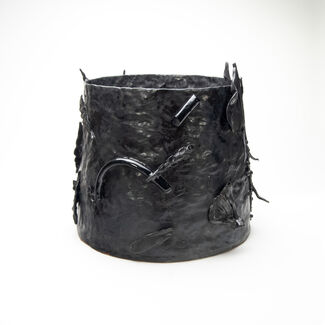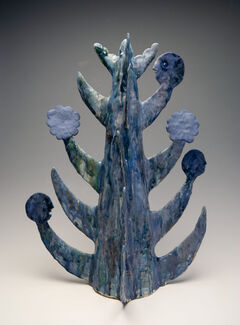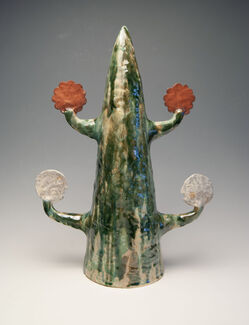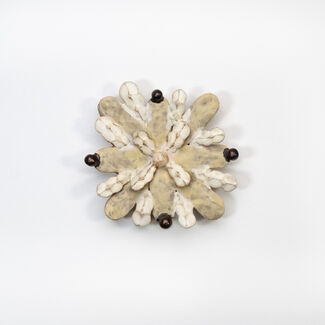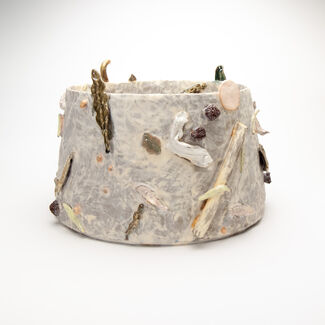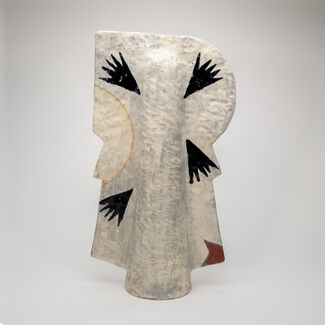| Ceramics: Wheel Throwing Fundamentals |
Ceramics |
1001 (001) |
Fall 2025 |
|
Description
This course will focus on developing beginning and continuing skills on the wheel. Students will be introduced to fundamental methods for using the wheel as a tool to create vessels with consideration of their meaning and consequence and stretch the boundaries of utility. In addition to the design and structure of functional objects, this course will familiarize students with the working properties of ceramic material, firing methods, and glazes.
We will look at artists working both in traditional and non-traditional methods. Artists will vary, but some we will look at include: Edmund de Waal, Alleghany Meadows, Gerrit Grimm, Mike Helke, Steve Lee, and more. Readings will include articles covering topics about the convergence of fine art and craft, how objects affect our daily life and rituals, the place of craft within contemporary society. Specific authors may be : Chris Staley, Glenn Adamson, Jenni Sorkin, Okakura Kakuzo and Edmund de Waal
Projects vary, but typically there are 5-6 assignments in the course with each assignment consisting of 3-20 pieces of finished work with additional research in glaze and firing processes. Students will also have readings and responsibilities with firing work.
|
Class Number
1184
Credits
3
|
| Throwing: Multilevel |
Ceramics |
2005 (002) |
Summer 2025 |
|
Description
This multilevel class is for students with or without experience in wheel throwing. Beginning students are introduced to ideas, materials and techniques for throwing vessels. They acquire the necessary skills to construct and analyze a wide range of vessel forms. Intermediate and advanced students continue their individual development of throwing, glazing and firing kilns. Course discussions focus on issues around the vessel to acquire critical understanding of containers and their functions, as well as using the wheel as a means for constructing sculptural forms.
|
Class Number
1169
Credits
3
|
| Top: Clay and Culture |
Ceramics |
2035 (001) |
Spring 2025 |
|
Description
This course examines a variety of cultures (African, North, Central and South American, European, Asian) through the lens of their ceramic histories. Students will develop vessels based on a response to this cultural information. Each projects will be rooted in a discussion and a tour with a different curator at AIC. Topics addressed will be: gender and sexuality, domestic and ritual vessels, architecture and environment, politics and culture and class and industry.
|
Class Number
1168
Credits
3
|
| Clay as Chameleon |
Ceramics |
2900 (021) |
Spring 2025 |
|
Description
Clay is an amazing material for an interdisciplinary artist to have in their repertoire. It can be as hard as stone one moment and you can also watch it disintegrate before your eyes the next. Throughout the centuries artists and craftspeople have capitalized on its transformative nature, sometimes even disguising it in plain sight. In this course we will see how artists from many backgrounds have used transformative materiality within their work.
ARTISTS/READINGS
Readings will vary but we will look at excerpts from articles like: Jo Dahn ¿New Directions in Ceramics¿, Jenni Sorkin ¿Pottery in Drag: Beatrice Wood and Camp¿, Paul Matheiu ¿The Radical Autonomy of Ceramics¿. A sample of artists whom we will be studying are: Bertozzi & Cassoni, Alexandra Engelfriet, Teri Frame, Shiyuan Xu, Claire Twomey, Marilyn Levine, Renata Cassiano Alvarez, Nina Hole, Jennifer Ling Datchuk, Andy Goldsworthy, Theaster Gates, Edmund de Waal, Magdalene Odundo and Pheobe Cummings
ASSIGNMENTS/PROJECTS
Course work will vary but typically includes weekly reading responses, biweekly mentoring meetings, engage in critique of both peer artwork as well as self-reflection on student¿s own work and a few small individual projects.
|
Class Number
2133
Credits
3
|
| 20,000 Years of Clay |
Ceramics |
3024 (001) |
Fall 2025 |
|
Description
This course surveys the history and production of clay and ceramics, from one of the earliest ceramic objects known, dating back some 20,000 years, to the present use of clay in contemporary art, design and craft. The course will take us through every continent and be looking at the use of ceramic in different cultures at different times though history. Attention will be given to the role clay and ceramic plays in our human development both as ritualistic, artistic and functional handmade and mass-produced objects. From ceramic in an ancient caves to NASA and the use of ceramic in space and everything in between.
Readings may include extracts from, 'Ten Thousand Years of Pottery' by Emannuel Cooper, 'Art, history, and gender: women and clay in West Africa' by Marla C. Berns , '20th Century Ceramics (World of Art)' by Edmund de Waal, 'Arita / Table of Contents: Studies in Japanese Porcelain' by Anniina Koivu and 'Vitamin C: Clay and Ceramic in Contemporary Art' by Clare Lilley and various essays by Nigel Wood, Tanja Harrod, Glenn Adamson and Namita Gupta Wiggers. Paired with exhibitions like the 2019 `The Journey of Things' by Magdalene Odundo The Hepworth Wakefield, The 2004 'A Secret History of Clay: From Gauguin to Gormley' at TATE Liverpool and the permanent ceramic collection at The Art Institute of Chicago.
Assignments include: working together to shape a research project proposal for a presentation on a specific part of the ceramic history, object-based written based on a piece of ceramics
|
Class Number
1187
Credits
3
|
| CER: Ceramics Senior Critique Studio |
Ceramics |
4905 (001) |
Fall 2025 |
|
Description
This course is a forum for in-depth critiques, technical, conceptual, and professional practice discussions based on the student¿s practice and research. The goal of this class is to provide students information and guidance on how they can continue with their art practice after school. Each student enrolled in the course will be assigned a studio space within the department. The course is open to Seniors only who have previously taken 9 credit hours of Ceramics classes, 2000-level and above. Students signing up for this class must also be enrolled in any 3 credit hour Ceramics class, 2000-level and above. Seniors may enroll in this course for two consecutive semesters only. Some of the books we will use as a reference for this class may be Living and Sustaining a Creative Life: Essays by 40 by Sharon Louden and ART/WORK: Everything You Need to Know (and Do) As You Pursue Your Art Career. Additionally, students will present to the class about an artist/thinker and/or participate in a skill sharing workshop. The format for this course is primary individual and group meetings, readings, presentations, field trips, exhibitions, and group critiques. Additionally, we will have a discussion with guest artists speaking about their work and the technicalities of how to continue with their art practice. Students will learn how to document, install, and promote their work. It is expected of the students to self-direct their own project culminating with a final exhibition project as part of their BFA or Gallery 1922. This course requires instructor consent. Fill out the form found at this link, https://tinyurl.com/35b26s78, to submit your portfolio and list of ceramics classes taken in the ceramics department.
|
Class Number
1163
Credits
3
|


